Apple Macintosh LC 630 DOS User Manual

Macintosh
User’sGuide
the Includes setup, troubleshooting, and important health-related information for the Macintosh LC 630 DOS Compatible
K Apple Computer, Inc.
© 1995 Apple Computer, Inc. All rights reserved.
Under the copyright laws, this manual may not be copied, in whole or in part, without the written consent of Apple. Your rights to the software are governed by the accompanying software license agreement.
The Apple logo is a trademark of Apple Computer, Inc., registered in the U.S. and other countries. Use of the “keyboard” Apple logo (Option-Shift-K) for commercial purposes without the prior written consent of Apple may constitute trademark infringement and unfair competition in violation of federal and state laws.
Every effort has been made to ensure that the information in this manual is accurate. Apple is not responsible for printing or clerical errors.
Apple Computer, Inc. 1 Infinite Loop
Cupertino, CA 95014-2084 (408) 996-1010
Apple, the Apple logo, AppleShare, AppleTalk, ImageWriter, LaserWriter, Macintosh, MacTCP, ProDOS, QuickTime, and StyleWriter are trademarks of Apple Computer, Inc., registered in the U.S. and other countries.
Apple Desktop Bus, AppleScript, Balloon Help, Disk First Aid, Finder, Macintosh PC Exchange, PlainTalk, PowerTalk, and QuickDraw GX are trademarks of Apple Computer, Inc.
Adobe, Adobe Illustrator, Adobe Photoshop, and PostScript are trademarks of Adobe Systems Incorporated, which may be registered in certain jurisdictions.
Epson is a registered trademark of Seiko Epson Corporation.
ExposurePro is a registered trademark of Baseline Publishing, Inc.
Helvetica and Times are registered trademarks of Linotype-Hell AG and/or its subsidiaries.
Hewlett-Packard, LaserJet, and PCL are registered trademarks of Hewlett-Packard Company.
MacLink Plus is a trademark of Data Viz., Inc.
Microsoft and MS-DOS are registered trademarks of Microsoft Corporation.Windows is a trademark of Microsoft Corporation and SoftWindows is a trademark used under license.
NetWare is a registered trademark of Novell, Inc.
QMS is a registered trademark of QMS, Inc.
QuarkXPress is a registered trademark of Quark, Inc.
Sound Blaster is a trademark of Creative Technology, Ltd.
SuperPaint is a trademark of Aldus Corporation, a subsidiary of Adobe Systems Incorporated which may be registered in certain jurisdictions.
Tektronix is a registered trademark of Tektronix, Inc.
Simultaneously published in the United States and Canada.
Mention of third-party products is for informational purposes only and constitutes neither an endorsement nor a recommendation. Apple assumes no responsibility with regard to the performance or use of these products.

Contents
|
Communications regulation information |
vii |
|
||||
Preface |
Your DOS-compatible Macintosh computer |
ix |
|||||
1 |
Getting Started |
1 |
|
|
|
|
|
|
Plugging in the computer |
1 |
|
|
|||
|
Installing an expansion card |
3 |
|
|
|||
|
Connecting a monitor |
3 |
|
|
|
||
|
Connecting the mouse and keyboard |
6 |
|
||||
|
Connecting other equipment |
7 |
|
|
|||
|
Turning the computer on |
8 |
|
|
|||
|
Problems turning your computer on? |
10 |
|
||||
|
What’s next? |
11 |
|
|
|
|
|
|
Learning the basics |
|
12 |
|
|
|
|
|
Reviewing the basics |
|
13 |
|
|
|
|
|
Turning the computer off |
14 |
|
|
|||
|
Where to find answers |
15 |
|
|
|
||
iii

2 Getting Help |
17 |
|
|
Getting answers to your questions |
18 |
||
Identifying objects on the screen |
26 |
||
Learning useful shortcuts |
27 |
|
|
3 Connecting Additional Equipment |
|
29 |
|
|
|
|||
Where to connect additional equipment |
|
30 |
|
|
||||
Connecting an Apple PlainTalk Microphone |
31 |
|
|
|||||
Connecting external stereo speakers |
32 |
|
|
|
||||
Connecting a game controller |
33 |
|
|
|
|
|
||
Expanding memory |
34 |
|
|
|
|
|
|
|
Installing internal drives |
34 |
|
|
|
|
|
|
|
4 Installing and Using Application Programs in the |
|
|
||||||
Macintosh Environment |
35 |
|
|
|
|
|
|
|
Installing Macintosh application programs |
36 |
|
|
|||||
Working with several programs at a time |
|
37 |
|
|
||||
Backing up your files |
38 |
|
|
|
|
|
|
|
5 Operating in the PC Environment |
|
39 |
|
|
|
|||
Switching between the Macintosh and PC environments |
|
40 |
||||||
Setting up the PC environment |
42 |
|
|
|
|
|
||
Working in the PC environment |
44 |
|
|
|
|
|
||
Running network software |
53 |
|
|
|
|
|
|
|
Using multimedia, MIDI, and game application programs |
54 |
|||||||
Using Macintosh peripherals in the PC environment |
55 |
|
||||||
Using PC peripherals |
59 |
|
|
|
|
|
|
|
iv Contents

6 Configuring the PC Environment |
61 |
|
|||
Choosing settings |
62 |
|
|
|
|
Configuring the PC serial ports |
63 |
|
|
||
Setting the monitor |
64 |
|
|
|
|
Setting the time and date |
64 |
|
|
|
|
Setting shared memory |
65 |
|
|
|
|
Choosing shared folders or volumes |
67 |
|
|||
Turning on PC sounds |
69 |
|
|
|
|
Configuring drives C and D |
70 |
|
|
||
Managing PC files from the Mac OS |
71 |
|
|||
Changing the size of the drive container |
72 |
||||
Understanding the status line |
76 |
|
|
||
7 Troubleshooting in the Macintosh Environment |
77 |
|
When you have questions |
77 |
|
When you run into trouble |
77 |
|
Solutions to common problems 80 |
|
|
Initializing a hard disk 93 |
|
|
Repairing a damaged disk |
97 |
|
Installing or reinstalling Mac OS system software |
102 |
|
8 Troubleshooting in the PC Environment |
113 |
When you have questions 113 |
|
Reinstalling the DOS-Compatibility Software |
119 |
Contents v

Appendix A Health, Safety, and Maintenance Tips |
129 |
|
|||
Health-related information about computer use |
129 |
||||
Safety instructions |
134 |
|
|
|
|
Handling your computer equipment |
135 |
|
|
||
Cleaning your equipment |
139 |
|
|
|
|
Locking and unlocking the mouse |
141 |
|
|
||
Appendix B Installing an Expansion Card or Memory for the PC Environment 143
Opening the computer |
145 |
|
|
Installing a communication card |
148 |
|
|
Installing a SIMM for the PC environment |
149 |
||
Closing the computer |
154 |
|
|
Appendix C Special Keys on Your Keyboard |
157 |
|
|
Appendix D Installing Macintosh Easy Open |
159 |
|
|
Choosing an application to open a document |
159 |
||
Using the Macintosh Easy Open control panel |
161 |
||
Appendix E Installing Network Management Software |
163 |
||
Installing NetWare client software |
163 |
|
|
Installing Novell’s LAN Workplace for DOS TCP/IP software 167 |
|||
Installing NetManage’s Chameleon TCP/IP software 169 |
|||
Installing Windows for Workgroups |
173 |
|
|
Installing Spry’s Air Series TCP/IP software |
173 |
||
Installing Mosaic 177 |
|
|
|
Index |
179 |
|
|
vi Contents

Communications regulation information
FCC statement
This equipment has been tested and found to comply with the limits for a Class B digital device in accordance with the specifications in Part 15 of FCC rules. See instructions if interference to radio or television reception is suspected.
Radio and television interference
The equipment described in this manual generates, uses, and can radiate radio-frequency energy. If it is not installed and used properly—that is, in strict accordance with Apple’s instructions—it may cause interference with radio and television reception.
This equipment has been tested and found to comply with the limits for a Class B digital device in accordance with the specifications in Part 15 of FCC rules. These specifications are designed to provide reasonable protection against such interference in a residential installation. However, there is no guarantee that interference will not occur in a particular installation.
You can determine whether your computer system is causing interference by turning it off. If the interference stops, it was probably caused by the computer or one of the peripheral devices.
If your computer system does cause interference to radio or television reception, try to correct the interference by using one or more of the following measures:
mTurn the television or radio antenna until the interference stops.
mMove the computer to one side or the other of the television or radio.
mMove the computer farther away from the television or radio.
mPlug the computer into an outlet that is on a different circuit from the television or radio. (That is, make certain the computer and the television or radio are on circuits controlled by different circuit breakers or fuses.)
If necessary, consult an Apple-authorized service provider or Apple. See the service and support information that came with your Apple product. Or, consult an experienced radio/television technician for additional suggestions. You may find the following booklet helpful: Interference Handbook (stock number 004-000-00493-1). This booklet, prepared by the Federal Communications Commission, is available from the U.S. Government Printing Office, Washington, DC 20402.
IMPORTANT Changes or modifications to this product not authorized by Apple Computer, Inc., could void the FCC Certification and negate your authority to operate the product.
This product was tested for FCC compliance under conditions that included the use of Apple peripheral devices and Apple shielded cables and connectors between system components. It is important that you use Apple peripheral devices and shielded cables and connectors between system components to reduce the possibility of causing interference to radios, television sets, and other electronic devices. You can obtain Apple peripheral devices and the proper shielded cables and connectors through an Apple-authorized dealer. For non-Apple peripheral devices, contact the manufacturer or dealer for assistance.
Communications regulation information |
vii |

DOC statement
DOC Class B Compliance This digital apparatus does not exceed the Class B limits for radio noise emissions from digital apparatus as set out in the interference-causing equipment standard entitled “Digital Apparatus,” ICES-003 of the Department of Communications.
Observation des normes—Classe B Cet appareil numérique respecte les limites de bruits radioélectriques applicables aux appareils numériques de Classe B prescrites dans la norme sur le matériel brouilleur : “Appareils Numériques”, NMB-003 édictée par le ministre des Communications.
VCCI statement
CD-ROM drive
WARNING Making adjustments or performing procedures other than those specified in your equipment’s manual may result in hazardous exposure.
WARNING Do not attempt to disassemble the cabinet containing the laser. The laser beam used in this product is harmful to the eyes. The use of optical instruments, such as magnifying lenses, with this product increases the potential hazard to your eyes. For your safety, have this equipment serviced only by an Apple-authorized service provider.
If you have an internal Apple CD-ROM drive in your computer, your computer is a Class 1 laser product. The Class 1 label, located on the computer, indicates that the drive meets minimum safety requirements. A service warning label is on the CD-ROM drive inside the computer.
viii Communications regulation information

Your DOS-Compatible Macintosh Computer
Your Macintosh includes hardware and software that let you use DOS and Windows application programs directly on your Macintosh computer. It contains a high-performance microprocessor that’s fully compatible with the latest DOS and Windows software. You can
msimultaneously run Macintosh operating system (Mac OS) and PC application programs
mswitch between the Mac OS and PC environment at any time without quitting the applications you’re using
mview the current environment on a single monitor
muse the same hard disk for both Mac OS and PC software
mshare files and folders (directories) between the Mac OS and the PC environment
mcut, copy, and paste data between Mac OS and DOS or Windows documents
muse your Macintosh keyboard and mouse with PC software
muse your Macintosh modem, monitor, and printer with PC software, or connect PC-compatible equipment
muse a joystick or other game controller with PC application programs
ix

mshare the random-access memory (RAM) in your Macintosh with the PC environment, or use a memory module (SIMM) for the exclusive use of the PC environment
muse the built-in Macintosh serial ports with PC software
maccess PC CD-ROM discs using an Apple CD-ROM drive
mplay Sound Blaster-compatible sounds
mcommunicate with network servers and other computers running PC software
To begin, follow the instructions in Chapters 1 and 2 to set up your computer and get started using it. Read Chapters 3 and 4 when you are ready to connect additional equipment to your computer and install
Mac OS application programs. Read Chapters 5 and 6 to start using DOS and Windows application programs on your Macintosh computer. Turn to Chapters 7 and 8 if you have questions or problems using your Macintosh.
x Your DOS-Compatible Macintosh Computer

Monitor |
Macintosh DOS-compatible computer |
Keyboard cable
(sometimes built into the keyboard as shown here)
Keyboard
Mouse
Monitor cable |
Computer power cord |
(sometimes built into the monitor)
Monitor power cord
(sometimes built into the monitor)
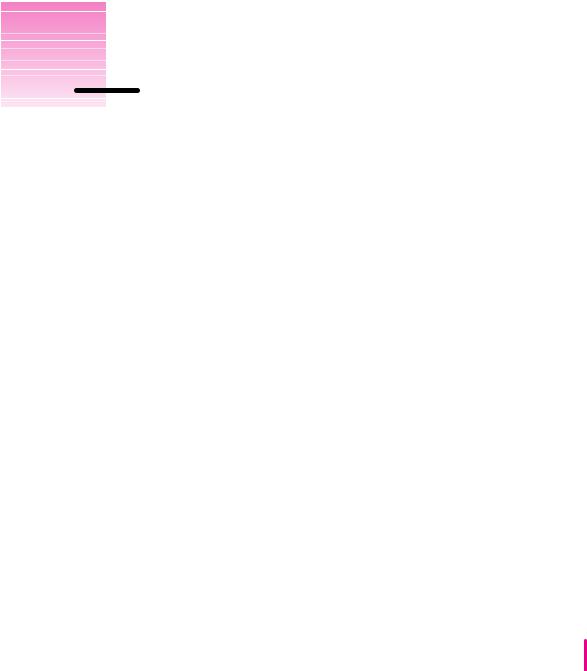
Follow the instructions in this
chapter to set up your computer
and learn the basics.
1 Getting Started
The illustration on the facing page shows all the equipment you need to set up your computer and begin using it. Place your equipment on a sturdy, flat surface near a grounded wall outlet. Before following the setup instructions in this chapter, you may want to read “Arranging Your Office” in Appendix A (in the section on health-related information) for tips on adjusting your work furniture so that you’re comfortable when using the computer.
Plugging in the computer
Before you plug your Macintosh into a wall socket, carefully read all the setup instructions in this chapter. Then, before you connect anything to your Macintosh, follow the instructions in this section to plug it in. The plug grounds the computer and protects it from electrical damage while you are setting up.
1

When you are ready to begin, follow these steps:
1Plug the socket end of the computer’s power cord into the recessed power cord socket (marked with the symbol ) on the back of the computer.
2Plug the other end of the power cord into a three-hole grounded outlet or power strip.
Choose a power outlet to which you have easy access.
WARNING This equipment is intended to be electrically grounded.Your Macintosh is equipped with a three-wire grounding plug—a plug that has a third (grounding) pin. This plug will fit only a grounded AC outlet. This is a safety feature. If you are unable to insert the plug into the outlet, contact a licensed electrician to replace the outlet with a properly grounded outlet. Do not defeat the purpose of the grounding plug!
Power cord plug |
Power cord socket |
Standby power button |
IMPORTANT Be sure that at least one end of the power cord is within easy reach so that you can unplug the computer when you need to.
If the computer starts up: If you hear a tone, the computer has started up and you need to turn it off before proceeding. Press the power button (also called the standby power button) located on the back of the computer to turn the computer off.
2 Chapter 1

Installing an expansion card
If you purchased any expansion cards for your Macintosh or extra memory for use in the PC environment, install the cards or memory now. (For instructions, see Appendix B, “Installing an Expansion Card or Memory for the PC Environment,” as well as the documentation that came with the cards or memory module.) If you don’t have an expansion card or memory to install, go on to the next section, “Connecting a Monitor.”
Connecting a monitor
You can connect many types of monitors to your Macintosh. To connect a monitor from a manufacturer other than Apple, refer to the instructions that came with the monitor.
Connecting the monitor power cord
Monitors have two cords to connect—a power cord and a monitor cable.
To connect the monitor power cord, follow these steps:
1Place the monitor where you will be using it.
You can place a monitor with a 15-inch or smaller screen on top of your computer. Don’t place larger monitors on the computer.
Keep these considerations in mind:
m Allow a few inches for air circulation around the sides of the computer and monitor.
m Make sure that the top of the screen is slightly below eye level when you’re sitting at the keyboard.
m Position the monitor to minimize glare and reflections on the screen from overhead lights and windows.
m Consult “Arranging Your Office” in the section “Health-Related Information About Computer Use” in Appendix A for suggestions on locating your computer equipment.
Getting Started |
3 |
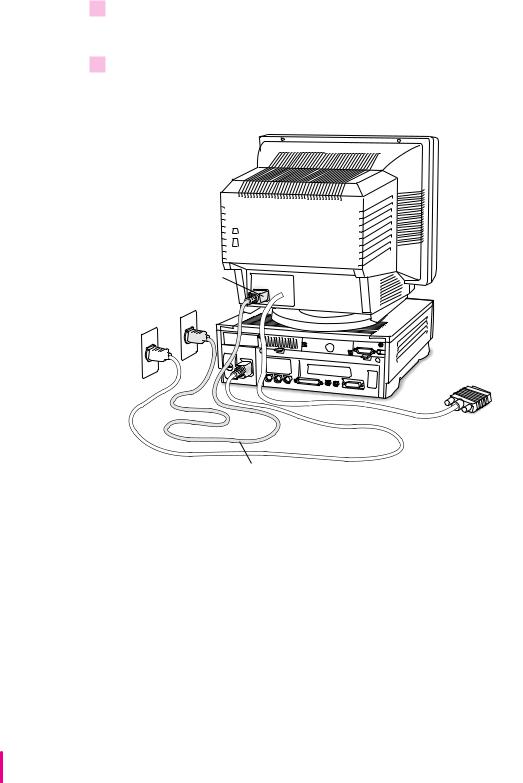
2Connect the monitor power cord to the monitor.
On some monitors, the cord is already attached.
3Plug in the monitor power cord.
Be sure to plug the power cord into a three-hole grounded outlet or power strip.
Monitor power socket
Monitor power cord
4 Chapter 1
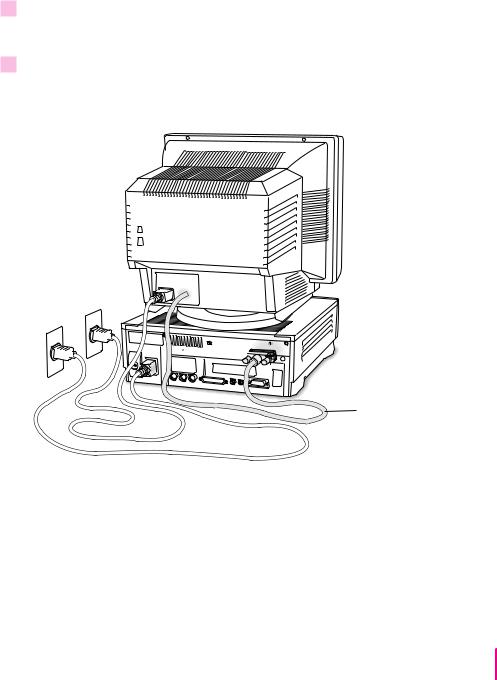
Connecting the monitor cable
After you plug in the monitor power cord, you connect the monitor cable to the computer’s monitor port.
To connect the monitor cable, follow these steps:
1Attach the monitor cable to the monitor.
On some monitors, the cable is already attached (as shown below).
2Attach the monitor cable to the monitor port on the back panel of the computer.
The monitor port is on the upper-right corner of the back panel. It is marked with the ™ icon (symbol). Be sure you plug the cable into the correct port.





 ™ Monitor port
™ Monitor port
Monitor cable
Getting Started |
5 |
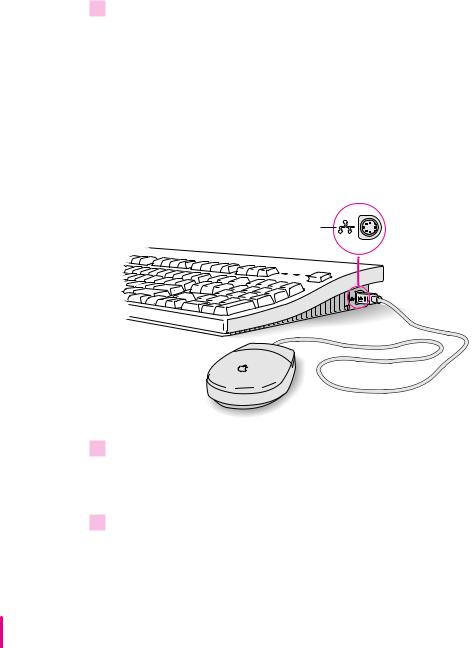
Connecting the mouse and keyboard
You have a choice of several keyboards for your Macintosh. The way you connect the mouse and keyboard depends on whether the keyboard has a separate cable or a built-in cable.
Connecting a keyboard with a separate cable
1Plug the mouse cable into the port on either side of the keyboard.
Most right-handed people prefer to use the mouse with their right hand; most left-handed people prefer to use their left hand. Plug the mouse into the port on the side you prefer.
The plug and the port are marked with the icon (symbol). Align the symbols before you insert the plug. (The positions of the port and icon on your keyboard may be different from those pictured here.)
By the way: A port marked with the icon is called an Apple Desktop Bus (ADB) port.
ADB icon
2Plug the keyboard cable (both ends are the same) into the other port on the keyboard.
If you plugged the mouse cable in on the right, for example, plug the keyboard cable in on the left.
3Plug the keyboard cable into the port marked with the icon on the back of the computer.
Some monitors have a port to which you can connect the keyboard or mouse. See the information that came with your monitor.
6 Chapter 1

Connecting a keyboard with a built-in cable
1Plug the mouse cable into the recessed port on the back of the keyboard.
The plug and the port are marked with the icon (symbol). The positions of the port and icon on your keyboard may be different from those pictured.
By the way: A port marked with the icon is called an Apple Desktop Bus (ADB) port.
Plug the mouse into the recessed port on the keyboard. The flat part of the plug should be pointing down, as shown here.
This cable plugs into the Apple Desktop Bus (ADB) port on the back of the computer. The ADB port on the computer is marked with the icon.
2Plug the keyboard cable into the port marked with the icon on the back of the computer.
Some monitors have a port to which you can connect the keyboard or mouse. See the information that came with your monitor.
Connecting other equipment
If you are new to the Macintosh, it’s a good idea to get some experience using your computer before you connect other equipment, such as a printer or scanner. To learn basic Macintosh skills, continue with the instructions in this chapter.
When you’re ready to connect other equipment to your Macintosh, see the instructions in Chapter 3.
Getting Started |
7 |
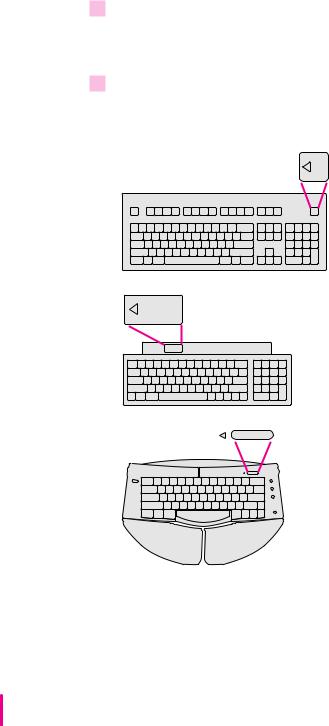
Turning the computer on
Follow these steps to turn the computer on:
1Turn on the monitor.
See the information that came with your monitor for the location of the power button.
2Turn on your computer by pressing the Power key.
The Power key is at the top of the keyboard. You can recognize this key by the triangle outline on it (P).
You hear a tone from the computer as it starts up.
8 Chapter 1
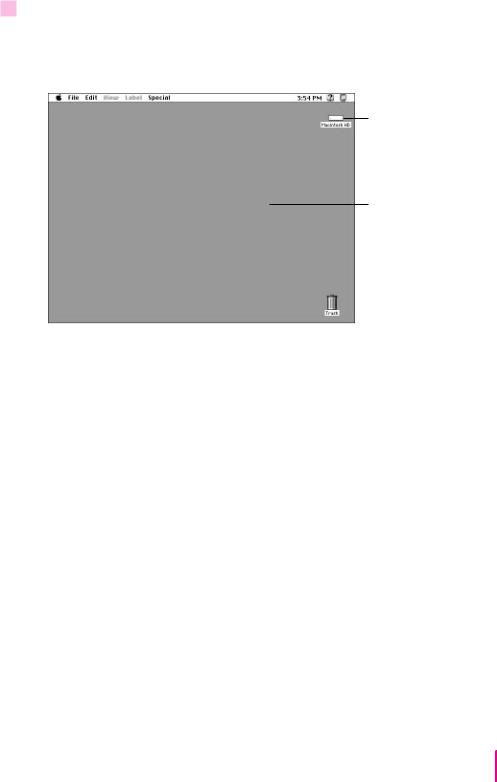
3Check to see what’s on your screen.
m If you see the Macintosh desktop, as in the illustration below, your system software has already been installed, and your computer is ready to use. Skip now to the section “What’s Next?” later in this chapter.
Hard disk icon
Macintosh desktop
mIf you see a blinking question mark, you need to install system software on your computer’s hard disk. (System software is the set of programs your computer uses to start itself up.) See “Installing or Reinstalling Mac OS System Software” in Chapter 7 for information on how to install system software.
mIf you see anything else on your screen, or nothing at all, see the next section, “Problems Turning Your Computer On?”
Getting Started |
9 |

Problems turning your computer on?
If you don’t see anything on the screen, check these items to see if you can identify the problem:
mIs the computer plugged into a power source? If it is plugged into a power strip, is the power strip turned on?
mIs the computer turned on? The power-on light on the front panel should be on. If it isn’t on, press the standby power button on the computer’s back panel (marked with the symbol ®).
mAre the keyboard and mouse cables connected correctly? (Don’t disconnect the keyboard or mouse cable while the computer is on. You could damage your equipment.)
mIs the monitor power cord plugged in?
mIs the monitor turned on? (Check the power-on light on the front of the monitor.)
mIs the monitor cable attached firmly to both the monitor and computer?
mIs the brightness control on the monitor adjusted correctly? (On Apple monitors, the brightness control is marked with the symbol ¤.)
10 Chapter 1

What’s next?
Congratulations! You’ve finished setting up your computer. Now continue with one of the following steps:
mIf you are new to the Macintosh, turn to the next section, “Learning the Basics.”
mIf you are an experienced Macintosh user, turn to Chapter 2, “Getting Help,” to learn about Macintosh Guide, your main source of information when you’re working with the Mac OS (the Macintosh environment).
mIf you want to connect other equipment, such as a printer, to your computer, see Chapter 3, “Connecting Additional Equipment.”
mIf you want to start using DOS or Windows application programs on your Macintosh, turn to Chapter 5, “Operating in the PC Environment.”
Before you begin working with your computer, be sure to read the important health and safety information in Appendix A.
IMPORTANT If you need to turn off your computer at any point, please see “Turning the Computer Off” later in this chapter. It is very important to use the correct procedure for shutting down your Macintosh before turning it off.
Getting Started |
11 |
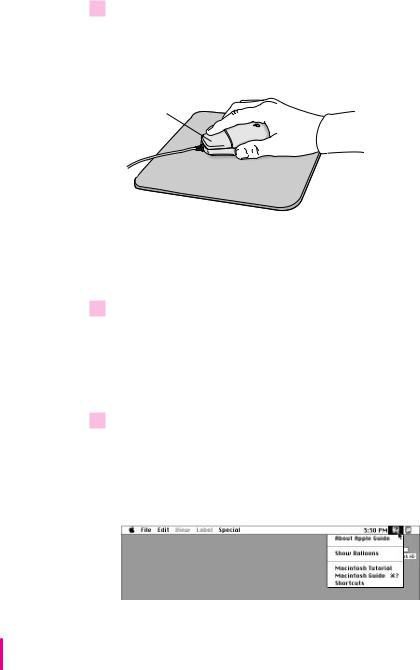
Learning the basics
If you are new to the Macintosh, you should begin by looking at the easy-to- use program called the Macintosh Tutorial. The tutorial teaches you the basic skills you’ll need to use your computer in the Macintosh environment. To start the tutorial, follow these steps:
1Slide the mouse along your mouse pad or desk.
Hold the mouse as shown, with the cable pointing away from you. Don’t press the mouse button (under your index finger). Notice that the arrow (8) on the screen moves in the same direction that you move the mouse.
Mouse button
If the arrow doesn’t move, make sure that the cables connecting the mouse and keyboard are secure and that your mouse is positioned as shown in the illustration.
2Move the tip of the arrow (8) to the question mark (h) in the upper-right portion of the screen.
If you run out of room on your mouse pad or desk while moving the mouse, pick up the mouse and place it where there’s more room. (The arrow on the screen moves only when the mouse is in contact with the mouse pad or desk.)
3With the tip of the arrow on the question mark, press and hold down the mouse button.
A list of choices (called a menu) appears. This is the Guide (h) menu, which is the place to go when you have a question about how to use your computer in the Macintosh environment (Mac OS). (The Guide [h] menu is not available when you’re in the PC environment.)
12 Chapter 1

4While holding down the mouse button, move the arrow until the words “Macintosh Tutorial” are highlighted, then release the mouse button.
A window appears welcoming you to the tutorial. You can set this book aside for now and follow the instructions on the screen. When you have completed the tutorial, return to this book.
Reviewing the basics
The strip across the top of the screen is called the menu bar. The symbols and words in it represent menus of commands.
Icons are small pictures that represent disks, folders, programs, and documents. To open an icon, click the icon twice quickly.
Windows are boxes that display text, graphics, or icons. To bring a partially covered window to the front, click anywhere in the window.
The following illustration summarizes many of the basic skills and terms you learned from the tutorial.
|
To find an answer to |
You can have several application |
||
|
a question about the |
programs open at once. To see which |
||
To move a window, |
Macintosh |
program is active or to switch from |
||
environment, look in |
one program to another, use this |
|||
drag it by the title bar. |
the Guide (h) menu. |
|
menu (called the Application menu). |
|
|
|
|
|
This icon represents your |
|
|
|
|
|
|
|
|
|
|
|
|
|
|
computer’s internal hard disk. |
|
|
|
|
|
|
|
|
|
|
|
To bring hidden portions of a |
To close a window, |
|
|
|
||
|
|
|
|||
|
|
||||
click the close box. |
|
window’s contents into view, |
|||
|
|
|
|
|
click the scroll arrows. |
To change the size or shape of a window, drag the size box.
To throw away an item you no longer want, drag it to the Trash and choose Empty Trash from the Special menu.
Getting Started |
13 |

Turning the computer off
To turn the computer off, you choose Shut Down from the Special menu.
Detailed instructions follow.
1 Move the tip of the arrow to the word “Special” at the top center of the screen.
If the word “Special” does not appear at the top of the screen, you’re working in the wrong program. Pull down the Application menu (to the right of the Guide [h] menu) and choose Finder. Then try step 1 again.
2With the tip of the arrow on the word “Special,” press and hold down the mouse button.
3While holding down the mouse button, move the arrow down the list of choices until the words “Shut Down” are highlighted, then release the mouse button.
You can also shut down your computer from the keyboard.
1Press the Power key (marked with a triangle) on the keyboard.
You will see a message asking whether you want to shut down or continue working.
2Click Shut Down.
To turn the computer on, simply press the Power key again.
WARNING Do not turn the computer off by pressing the standby power button on the back panel. If you do so, you may lose any work you haven’t previously saved to a disk. You also risk losing any open documents.
14 Chapter 1
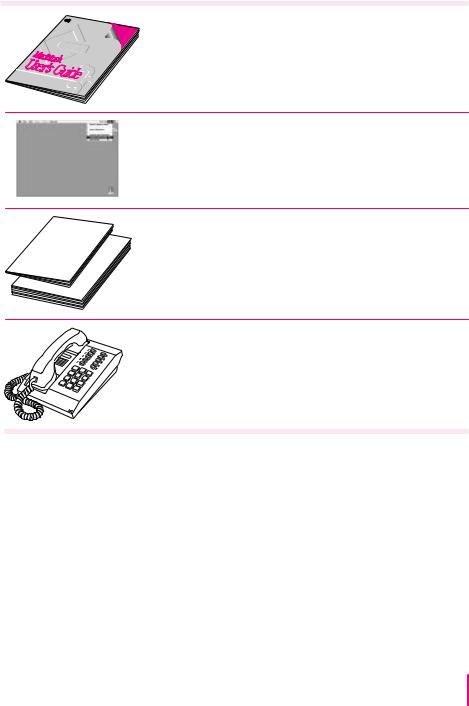
Where to find answers
When you have questions about using your Macintosh, there are several places you can look for answers.
Macintosh
User’sGuide
In this book
Use this book to help you set up your computer and learn about it, or to find solutions to problems.
In the Guide menu
The Guide menu (marked with the h icon) is your main source of information about the Macintosh environment. To learn how to get different kinds of help from the Guide menu, see Chapter 2 in this book.
In other manuals
For answers to questions about other equipment or about application programs you have purchased, see the manuals that came with the equipment or programs. Manuals for DOS and Windows are included with your computer.
From Apple’s customer support hotline
If you can’t find an answer in any of the materials provided, call the customer support hotline. (The phone number for the hotline is in the service and support information that came with your computer.)
Getting Started |
15 |

Use the instructions in this chapter to learn about the help available to you in the Guide menu.
2 Getting Help
The Guide menu is your main source of information when you’re working with your computer in the Macintosh environment. The menu is identified by a question mark (h) in the upper-right corner of the screen.
(If you need instructions on using DOS or Windows, see the appropriate manual.)
17
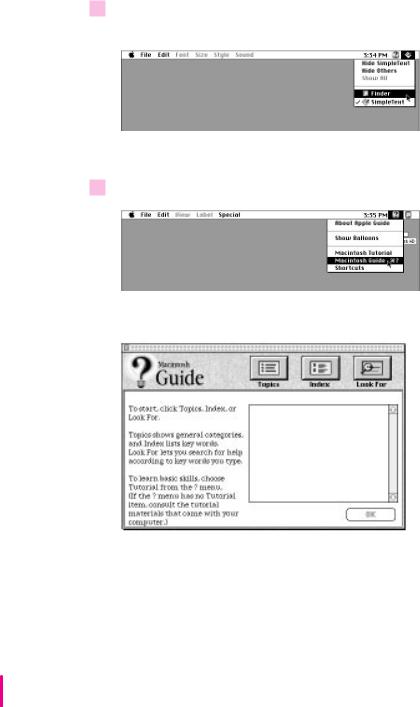
Getting answers to your questions
When you have a question while working in the Macintosh environment, you can get the answer by choosing Macintosh Guide from the Guide menu.
1Pull down the Application menu (in the upper-right corner of the screen) and choose Finder to make it the active application program.
A checkmark in the menu indicates that the Finder is the active program.
2 Pull down the Guide menu (marked with the h icon) and choose Macintosh Guide.
The Macintosh Guide window appears.
Whenever you use Macintosh Guide, its window remains in front of other windows. If the window gets in your way, you can move it by dragging its title bar (the gray bar across the top of the window).
18 Chapter 2
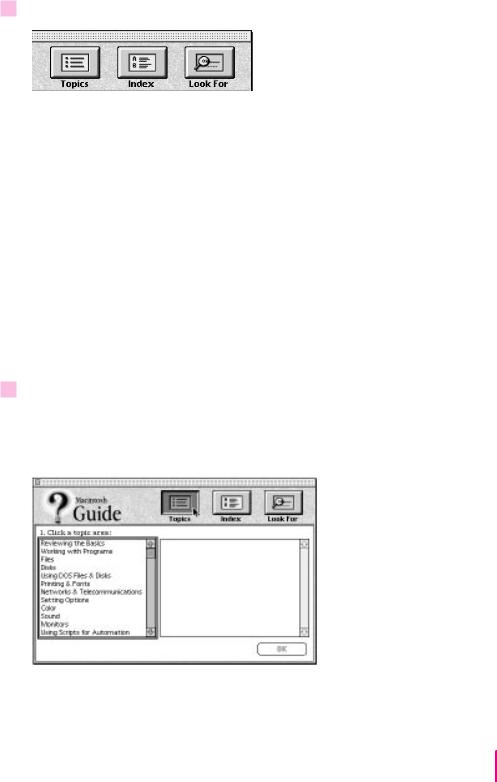
3 Notice the three buttons at the top of the window: Topics, Index, and Look For.
Macintosh Guide gives you three ways of finding information:
mTopics lets you choose from a list of general subjects; it is like the table of contents in a book.
mIndex lets you choose from an alphabetical list of more specific subjects; it is like the index in a book.
mLook For lets you search for information related to a specific word or phrase that you type.
In the following sections you will practice using each method.
If you have problems while using Macintosh Guide, see “Tips for Using Macintosh Guide” later in this chapter.
Getting answers with the Topics button
1In the Macintosh Guide window, click the Topics button.
A list of general topics appears on the left side of the Macintosh Guide window. (Depending on the hardware and software you have, the list of topics may look different.)
Getting Help |
19 |
